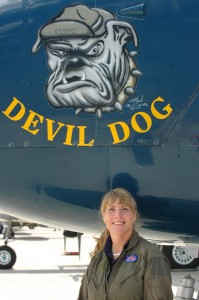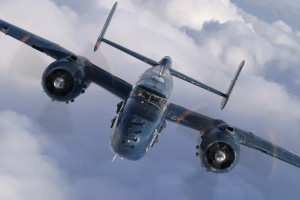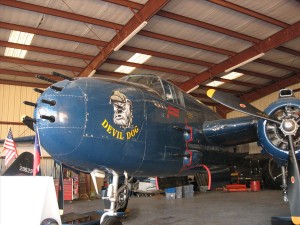
Devil Dog is a PBJ-1J, the Marine version of the North American B-25 Mitchell medium bomber. Beth Jenkins, the pilot who often flies Devil Dog to air shows, is the only female certified to fly this type of plane for the CAF.
By Jim Stanley
During five of the last seven years, a PBJ-1J, the Marine version of the North American B-25 Mitchell medium bomber, has flown into Oshkosh, Wis., for AirVenture. This Commemorative Air Force bomber, named Devil Dog, is the sole aircraft in the CAF squadron of the same name. The pilot who often flies Devil Dog to air shows is the only female certified to fly this type of plane for the CAF.
In the historic city of Georgetown, Texas, this accomplished aviatrix owns and operates a small, busy fixed base operation at Georgetown Municipal Airport. She’s a professional pilot and instructor who has logged more than 17,000 flight hours over the last 28 years.
Beth Jenkins operates her FBO, Pilot’s Choice Aviation, from a large hangar/administration building near the north end of the main airport runway. She has five full-time employees, plus several part-time instructors. She offers ground and flight instruction, aircraft rental, maintenance, sales, charter service and pilot supplies.
Pilots Choice is the largest nongovernment-sponsored flight training school in central Texas. It offers ground and flight instruction, from the basic solo license to the airline transport pilot certificate.
Jenkins usually flies about 90 hours per month and has endorsed 800 flight ratings, of which 500 have been flight instructor ratings.
Jenkins began her aviation career in 1980, when her father bought an airplane. As a birthday present, he took her up for her first airplane ride. She was hooked.
“Dad was trained by the Navy in World War II,” says Jenkins. “He was about to be deployed to Europe when the war ended. When I was small, he owned several airplanes for business use.”
Jenkins earned her private pilot, single-engine land certificate on July 31, 1981, and five months later, graduated from the University of Texas with a business management degree.

Beth Jenkins and other certified pilots of the squadron fly Devil Dog in air shows and demonstrations arranged by the CAF, including the annual Central Texas Airshow in Temple, Texas.
To pursue an aviation career, Jenkins attended Texas State Technical Institute, where she obtained her instrument, commercial and multi-engine land. Eventually, on July 21, 1983, she received her flight instructor, airplane single-engine land.
Her instructing career began in Killeen, Texas, with The Plane Thing flying school. Jenkins advanced with the school and opened a branch facility at Georgetown. Then in 1986, she purchased the Georgetown school and incorporated as Pilot’s Choice Aviation Inc.
“I organized my first air show, a small fly-in, with aircraft from the CAF,” says Jenkins. “Thus started my passion for warbirds and flying them.”
She joined the Yellow Rose Squadron, a B-25 group of the CAF. Later, in 1996, she joined the Devil Dog Sponsor group, which maintained and flew a North American PBJ-1J patrol bomber.
“The CAF charges a one-time fee of $3,500 to sponsor a multi-engine aircraft,” Jenkins said. “All hangar space and maintenance of the plane are responsibilities of the sponsor.”
In 1943, North American Aviation produced more B-25s than the Army Air Force needed, so some 706 of these planes, similar to the B-25J, were pulled from production lines and assigned to the Navy and Marine Corps.
The B-25J was powered by two Wright 2600-13 Cyclone radial piston engines rated at 1,700 hp at takeoff. Maximum speed was 275 mph at 13,000 feet, its service ceiling was 24,200 feet and the range was 1,350 miles. Wingspan was just over 67 feet, its length was 53 feet and empty weight was 19,480 pounds. The Marine Corps version could carry 3,200 pounds of bombs or one aerial torpedo and was defended by 16 .50 caliber machine guns.
Although 16 B-25s had been flown off the USS Hornet in the Doolittle Raid on Tokyo in a one-way mission in May 1942, the Navy couldn’t use the aircraft for regular carrier operations, because the B-25 was too large to land on a carrier of that era. However, the Marines did have a need for a medium bomber for patrol duty in anti-shipping missions and for close support of ground troops. For this low altitude work, the PBJs were modified by replacing the glass bombardier’s nose with a solid nose armed with eight .50 caliber machine guns, or in some versions, with a 75 mm cannon.

A dedicated group of volunteers maintains Devil Dog. The airplane is kept in the Pilot’s Choice Aviation hangar at Georgetown Municipal Airport.
In 1990, the Devil Dog Sponsor Group became the Devil Dog Squadron of the CAF. Devil Dog is painted Navy blue. Its nose art came about by Ozzie Perrish, the person who initially restored the plane, to honor the Marines and let the public know that the Marines had B-25s or PBJ1-Js. The name Devil Dog comes from the German “teufelshunde,” the title given the Marines who savagely battled the Germans at Belleau Wood in World War I.
Devil Dog was restored to replicate the number three aircraft for the VMB-612 squadron. Perrish had been a member of that squadron and wanted to remember his friends who were lost when the #3 ship never came back from her 23rd mission during WWII.
VMB-612 was stationed on Saipan in 1944 and flew long-range rocket attacks on Iwo Jima and Chichi Jima. It later moved to Iwo Jima after Marines secured the island, striking enemy shipping and other targets along the China coast.
A dedicated group of volunteers maintains Devil Dog, housed in Jenkins’ hangar. Jenkins and other certified pilots of the squadron fly the PBJ-1J in air shows and demonstrations arranged by the CAF, as well as an occasional fly-by on invitation, for a dedication or other event in locations all over the southwest. It appears at the annual Central Texas Airshow in Temple, Texas.
“I flew right seat for about five years, then graduated to the long sought-after left seat,” says Jenkins.
Devil Dog is in need of a major overhaul, which will cost about $60,000. The volunteer group in Georgetown is busy trying to raise money, selling shirts and souvenirs at Oshkosh last year and planning other fundraising events.
“If anyone you know is willing to donate, we can certainly use it,” Jenkins said.
For more Devil Dog information, visit [http://www.devildogsquadron.com]. For information on Pilot’s Choice Aviation, call 512-869-1759 or visit [http://www.pilotschoice.com].











